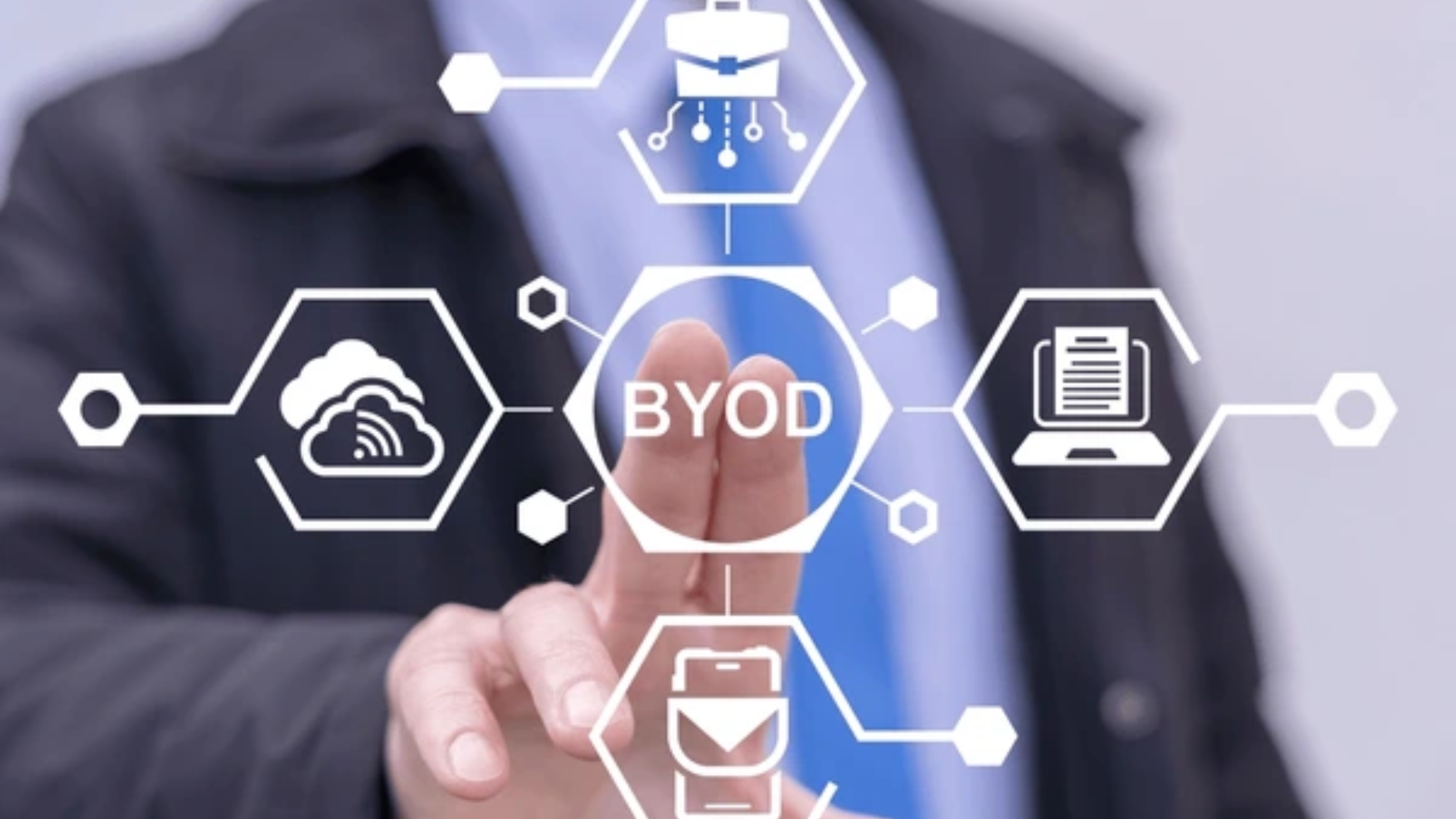In today’s fast-paced, mobile-driven world, employees want the flexibility to work from their own devices—whether it’s a laptop, smartphone, or tablet. This shift has given rise to the concept of Bring Your Own Device (BYOD), a practice where employees use their personal devices for work.
BYOD policies are rapidly gaining popularity among organizations across industries. They offer a way to increase productivity and reduce costs, but they also introduce significant security challenges. Managing personal devices such as smartphones, laptops, or tablets that connect to your company network requires careful planning and security measures to prevent potential data breaches or unauthorized access.
This article aims to clearly define BYOD, explore its benefits and challenges, and provide best practices for implementing a successful BYOD program. Whether you’re a small business or a large enterprise, understanding what BYOD entails is crucial for balancing flexibility with security.
Defining Bring Your Own Device (BYOD)
Bring Your Own Device (BYOD) is a workplace trend that allows employees to use their personal devices—such as smartphones, tablets, and laptops—to access work-related applications, data, and networks. Instead of relying solely on company-owned hardware, organizations enable their staff to use devices they’re comfortable and familiar with, fostering flexibility and mobility.
How BYOD works
With a BYOD policy in place, employees can connect their personal devices to the company network or access corporate resources remotely. This approach leverages the device’s existing operating system—whether it’s iOS, Android, Windows, or macOS—to facilitate work tasks while applying specific security measures to protect sensitive company data.
A brief history of BYOD in the corporate environment
The BYOD movement gained traction in the early 2010s as smartphones became ubiquitous and organizations recognized the potential cost savings and productivity improvements. Initially seen as a way to empower employees, BYOD has evolved into a strategic approach that also requires careful security measures to mitigate security risks such as data breaches and unauthorized access.
As organizations have increasingly adopted flexible work arrangements—especially in response to evolving workplace dynamics—the importance of BYOD policies has grown alongside advances in mobile device management (MDM) and unified endpoint management (UEM) solutions. These tools help manage devices effectively, ensuring that personal devices can be used securely within the corporate ecosystem.
Key features of BYOD
Implementing a successful BYOD program involves understanding its core features, which ensure employees can use personal devices securely and efficiently for work. Here are some of the key aspects:
Employee-owned devices used for accessing company data
At the heart of BYOD is the use of personal devices—such as smartphones, tablets, and laptops—to access corporate resources. These devices often run different operating systems, requiring flexible management solutions that can support cross-platform compatibility.
Integration of personal devices with enterprise infrastructure
A well-designed BYOD program allows personal devices to seamlessly connect with corporate systems—such as email, VPNs, and cloud apps—while maintaining security standards. This integration enhances productivity without compromising data integrity.
Usage across different platforms (iOS, Android, Windows, macOS)
The modern workforce uses a variety of operating systems. A robust BYOD strategy supports iOS (Apple devices), Android, Windows, and macOS, enabling employees to work on their preferred platforms while adhering to company security policies.
Security and management considerations
Because personal devices typically contain sensitive company data, organizations must adopt security measures such as data encryption, secure access controls, and remote wipe capabilities. Employing mobile device management (MDM) or unified endpoint management (UEM) solutions is critical to enforcing consistent security policies across all platforms.
Benefits of implementing BYOD
Adopting a Bring Your Own Device (BYOD) approach offers numerous advantages for both organizations and employees. When managed correctly, a BYOD program can significantly boost productivity, reduce costs, and enhance flexibility. Here are some of the key benefits:
Increased employee productivity and satisfaction
Employees tend to be more comfortable and productive when they work on devices they already know and love. Allowing personal devices means faster onboarding, easier access to work tools, and a more flexible work environment—whether in the office or remote.
Cost savings for organizations
By enabling employees to use their own laptops, smartphones, and tablets, companies can reduce the costs associated with purchasing and maintaining corporate-owned hardware. This shift often results in lower capital expenditure and improved budget allocation.
Flexibility and remote work enablement
A BYOD policy supports the growing trend of remote and hybrid work models. Employees can work from anywhere using their personal devices, which maintains continuity and collaboration across distributed teams, all while saving organizational resources.
Faster onboarding and access to tools
Employees can start working immediately with their personal device, without waiting for IT to distribute and configure corporate-owned hardware. Implementing a BYOD approach accelerates workflows and speeds up project timelines.
Challenges and risks of BYOD
While BYOD offers many advantages, it also introduces several significant challenges that organizations must address. These risks can threaten data security, employee privacy, and compliance if not managed properly.
Security concerns: data breaches, malware, unauthorized access
Personal devices connecting to the company network can become entry points for cyber threats. Without proper security measures, these devices may expose the organization to security vulnerabilities, including malware infections, data breaches, and unauthorized access to sensitive information.
Privacy issues for employees and employers
Allowing personal devices to access corporate data creates a balance between BYOD security and employee privacy. Employees may be concerned about employer access to personal data, while employers need control to protect sensitive company data. Finding a mutual agreement that respects privacy without compromising security is often challenging.
Compliance with regulations (GDPR, HIPAA, etc.)
Regulatory standards like GDPR or HIPAA impose strict requirements on how organizations handle personal data and sensitive information. Implementing a BYOD program that supports compliance can be complex, requiring careful policies, encryption, and audit procedures to prevent data breaches and legal penalties.
Device management complexity
Managing a BYOD environment involves overseeing a diverse range of device types, models, operating systems, and user preferences. Ensuring consistent security policies and managing devices without infringing on personal privacy demands sophisticated mobile device management (MDM) or unified endpoint management (UEM) solutions.
Best practices for a successful BYOD program
Achieving a secure and efficient BYOD environment requires careful planning and clear policies. Implementing the following best practices can help organizations maximize benefits while minimizing risks:
Clear BYOD policies and employee agreements
Start with well-defined BYOD policies that clearly outline employee responsibilities, security expectations, and acceptable device usage. These policies should include guidelines on data handling, reporting lost or stolen devices, and privacy considerations. Ensure all employees sign employee agreements acknowledging these policies.
Implementing Mobile Device Management (MDM) solutions
Leverage MDM or unified endpoint management (UEM) platforms to enforce security policies, remotely manage devices, and control access to sensitive company data. These solutions allow businesses to manage devices without intruding on personal privacy and enable security measures such as device encryption, password enforcement, and remote wipe functions if a device is lost or stolen.
Ensuring data encryption and secure access
Protect sensitive information by enforcing encryption and secure communication protocols such as VPNs. Use multi-factor authentication (MFA) for accessing corporate resources and ensure that data stored on personal devices is encrypted to prevent data breaches.
Regular security training and awareness programs
Educate employees about BYOD security best practices, including recognizing phishing attacks, avoiding suspicious apps, and reporting security incidents promptly. Ongoing training helps foster a security-conscious culture and reinforces the importance of protecting the company network and data.
Balancing security with employee privacy
Respect personal privacy by clearly communicating how management solutions like MDM will be used, and what level of access the company has. Employ privacy-aware management practices, such as separating corporate data from personal data through containerization or sandboxing, to maintain trust and compliance.

Real-world examples and case studies of BYOD in action
Understanding how different organizations implement BYOD policies can highlight best practices and illustrate real-world benefits and challenges. Here are a few examples:
Tech startup embracing BYOD for agile workflows
A fast-growing tech startup implemented a BYOD program to support their remote and flexible work culture. Employees used their personal smartphones and laptops to access company resources through mobile device management (MDM) tools like Microsoft Intune. The company established strict security measures, including data encryption and secure access controls.
- Outcome:
Increased employee satisfaction and productivity, faster onboarding, and reduced hardware costs. The company maintained BYOD security and minimized security vulnerabilities despite a diverse device ecosystem.
Healthcare organization managing sensitive data securely
A healthcare provider needed to ensure sensitive information like patient records remained protected while enabling mobile access for staff. They adopted a BYOD approach with MDM solutions integrated with healthcare-specific compliance measures such as HIPAA.
- Outcome:
The organization successfully enabled personal devices to access sensitive company data securely, reducing data breaches and maintaining compliance, while respecting employee privacy.
Small businesses are reducing costs through BYOD
A small business in the retail sector allowed employees to bring their own devices to reduce equipment costs. They implemented security measures like device encryption and multi-factor authentication, along with a clear BYOD policy.
- Outcome:
Lowered capital expenses and increased operational flexibility. By aligning policies and security measures, they avoided major BYOD security issues and kept the company network safe.
Creating a secure and productive BYOD environment
When managed properly, BYOD can reduce costs, improve employee satisfaction, and enable more agile operations. But success requires balancing BYOD security with employee privacy, constantly updating policies, and staying ahead of emerging trends.
The key takeaway? Craft a tailored BYOD program that aligns with your organizational goals, ensures security, and supports your workforce’s needs.
FAQs
1. What is BYOD, and how does it work?
Bring Your Own Device (BYOD) lets employees use their personal phones, laptops, and tablets to access work apps, email, and data. IT publishes security and usage policies, enrolls devices through an MDM/UEM tool (e.g., Intune, Jamf, Workspace ONE), and applies light-touch controls—like passcodes, encryption, and app-level protections—so corporate data stays secure without taking over the whole device.
2. What are the biggest benefits—and risks—of BYOD?
Benefits
- Higher productivity (people use devices they already know)
- Faster onboarding and lower hardware costs
- Better support for remote and hybrid work
Risks
- Data leakage from unmanaged apps or lost devices
- Malware and phishing on personal devices
- Privacy concerns and regulatory non-compliance (e.g., GDPR, HIPAA)
The fix is policy + tooling: clear rules, security baselines, and automated compliance.
3. What best practices should we implement to secure BYOD?
- Use MDM/UEM with the right enrollment mode: iOS User Enrollment, Android Work Profile, Windows app protection—so work data lives in a managed container.
- Enforce access controls: MFA, Conditional Access/Zero Trust, device compliance checks before letting users in.
- Protect data at rest and in transit: full-disk encryption, app protection policies (copy/paste, open-in controls), per-app VPN.
- Keep devices healthy: automated patching, OS/app update rings, threat detection/AV.
- Prepare for incidents: remote lock/wipe (corporate data only), rapid credential rotation, and auditable logs.
- Train users: short, recurring awareness on phishing, safe apps, and reporting lost devices.
4. How do we balance employee privacy with corporate security in BYOD?
Adopt privacy-aware controls and make them explicit:
- Separate work from personal: use containers/sandboxes so IT can wipe corporate data without touching photos, messages, or personal apps.
- Minimize telemetry: collect only what’s needed (device model, OS version, compliance state)—not personal content or location history.
- Be transparent: publish a plain-English BYOD policy and consent form that explains what IT can/can’t see or do.
- Define exit steps: on offboarding, remove corporate profiles, revoke access tokens, and provide a receipt of actions.







